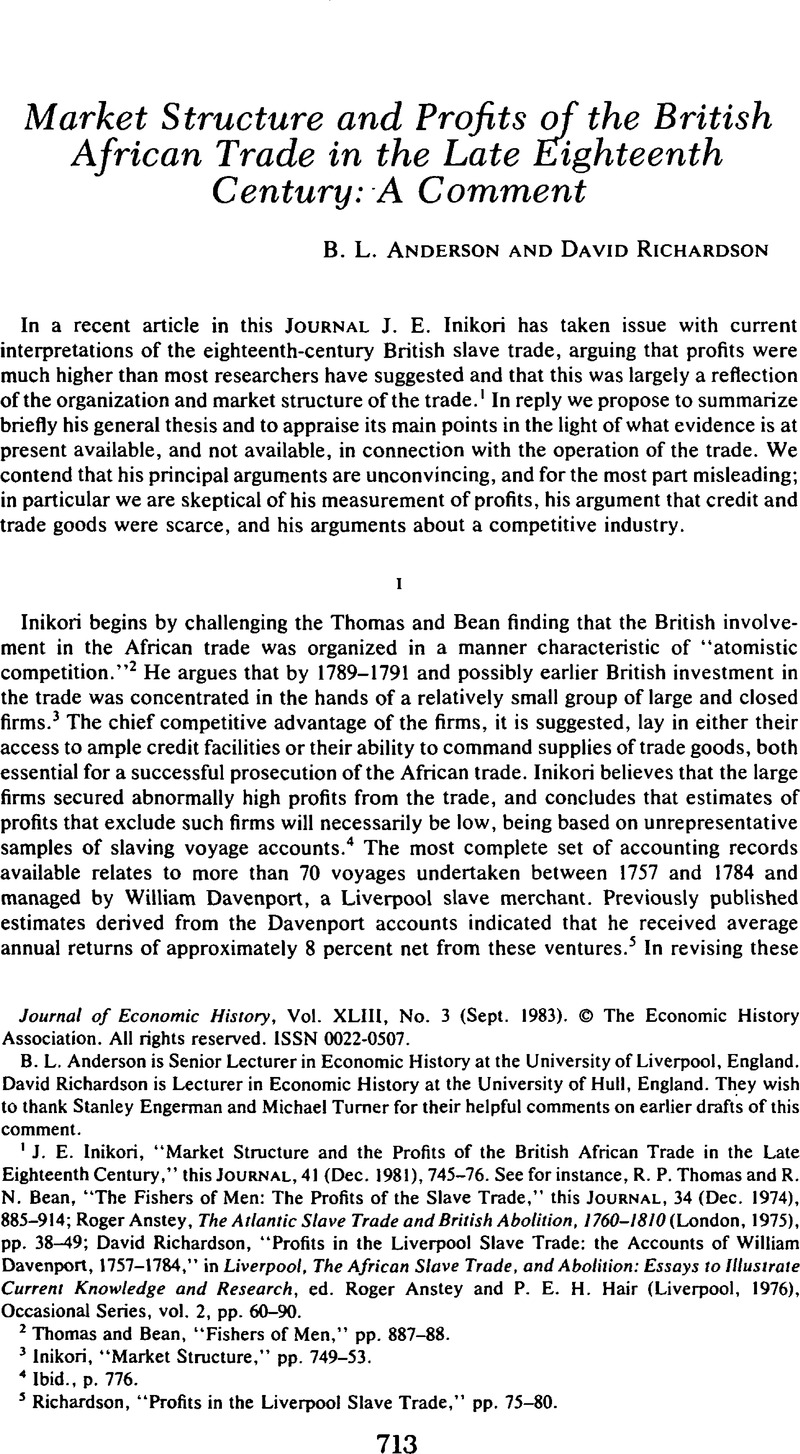Published online by Cambridge University Press: 03 March 2009

B. L. Anderson is Senior Lecturer in Economic History at the University of Liverpool, England. David Richardson is Lecturer in Economic History at the University of Hull, England. They wish to thank Stanley Engerman and Michael Turner for their helpful comments on earlier drafts of this comment.
1 Inikori, J. E., “Market Structure and the Profits of the British African Trade in the Late Eighteenth Century,” this JOURJAL, 41 (12. 1981), 745–76.Google Scholar
See for instance, R. P. Thomas and R. N. Bean, “The Fishers of Men: The Profits of the Slave Trade,” this Journal, 34 (12. 1974), 885–914; Anstey, Roger, The Atlantic Slave Trade and British Abolition, 1760–1810 (London, 1975), pp. 38–49;CrossRefGoogle ScholarRichardson, David, “Profits in the Liverpool Slave Trade: the Accounts of William Davenport, 1757–1784,” in Liverpool, The African Slave Trade, and Abolition: Essays to Illustrate Current Knowledge and Research, ed. Anstey, Roger and Hair, P. E. H. (Liverpool, 1976), Occasional Series, vol. 2, pp. 60–90.Google Scholar
2 Thomas, and Bean, , “Fishers of Men,” pp. 887–88.Google Scholar
3 Inikori, , “Market Structure,” pp. 749–53.Google Scholar
4 Ibid., p. 776.
5 Richardson, , “Profits in the Liverpool Slave Trade,” pp. 75–80.Google Scholar
6 Inikori, , “Market Structure,” pp. 767–68.Google Scholar
7 Ibid., pp. 771–72.
8 Ibid., p. 773, Table 5; Williams, Eric, Capitalism and Slavery (London, 1964 edition), pp. 36–37. There are some errors in Inikori's profit or loss calculations in Table 5.Google Scholar
9 Inikori, , “Market Structure,” p. 776.Google Scholar
10 Ibid., pp. 771–72.
11 These conclusions are based on Richardson, , “Profits in the Liverpool Slave Trade,” p. 80Google Scholar, and Anderson, B. L., “The Lancashire bill system and its Liverpool practitioners: the case of a slave merchant,” in Trade and Transport:Essays in economic history in honour of T. S. Willan, ed. Chaloner, W. H. and Ratcliffe, B. M. (Manchester, 1977), pp. 59–97; Davenport Trading and Bill Accounts, Raymond Richards Collection, University of Keele Library, Keele, England.Google Scholar
12 Richardson, , “Profits in the Liverpool Slave Trade,” pp. 64–69.Google Scholar
13 Lamb, D. P., “Volume and Tonnage of the Liverpool Slave Trade, 1772–1807,” in Liverpool, African Slave Trade, and Abolition, p. 92;Google ScholarRawley, J. A., The Transatlantic Slave Trade (New York, 1981), p. 180.Google Scholar
14 Richardson, , “Profits in the Liverpool Slave Trade,” p. 76.Google Scholar
15 Inikori, , “Market Structure,” p. 773.Google Scholar
16 Liverpool Record Office [henceforth, LRO], 387 MD 42.
17 Anderson, , “The Lancashire bill system,” p. 78.Google Scholar
18 lnikori, , “Market Structure,” p. 768.Google Scholar
19 Ibid. Inikori writes: “The annual rate of return should be calculated with only the merchant's original cash outlay as the base, since the slave trader certainly judged his performance in terms of the amount of cash (borrowed or personal) which he actually put into a given venture” (emphasis added). No evidence is offered to support this assertion.
20 Richardson, , “Profits in the Liverpool Slave Trade,” p. 76.Google Scholar
21 Davis, Ralph, Aleppo and Devonshire Square: English Traders in the Levant in the Eighteenth Century (London, 1967), p. 222 (emphasis added).CrossRefGoogle Scholar
22 See the statements of Norris and Bosanquet above.
23 Inikori, , “Market Structure,” pp. 774–75.Google Scholar
24 Ibid., pp. 753–56.
25 On p. 767 footnote 79, Inikori states that “Textiles and firearms formed over three-quarters of the value of cargo for each venture.” The meaning of this undocumented statement is not clear, however, for Inikori does not specify what textiles he is referring to and whether he means to cover slaving ventures generally or a limited number. In any case it is clear that textiles and firearms did not constitute 75 percent or more of the trade good exported to Africa in the eighteenth century. See Richardson, David, “West African Consumption Patterns and their Influence on the Eighteenth Century English Slave Trade,” in The Uncommon Market: Essays in the Economic History of the Atlantic Slave Trade, eds. Gemery, H. A. and Hogendorn, J. S. (New York, 1979), pp. 312–15.Google Scholar
26 Wadsworth, A. P. and de L. Mann, J., The Cotton Trade and Industrial Lancashire 1600–1780 (Manchester, 1931), pp. 148–61.Google Scholar
27 Galton, Samuel to Snr, John Parr, Galton Papers, 405/1, 20 05 1752, Birmingham Central Library; James Fraser to Samuel Galton, 19 05 1752, 408/12, Birmingham Central Library.Google Scholar
28 Inikori, , “Market Structure,” pp. 757–58.Google Scholar
29 LRO, Letter Book of Leyland, Thomas, 05 1786–09 1788, pp. 12, 604, 387 MD 59.Google Scholar
30 Inikori, , “Market Structure,” p. 757.Google Scholar
31 Public Record Office [henceforth, PRO], Caton, Joseph to Rogers, James, 2 12 1790, Chancery Masters' Exhibits, C. 107/13.Google Scholar
32 Based on Richardson, , “Profits in the Liverpool Slave Trade,” pp. 82–87; LRO, Account Book of John Tomlinson with John Knight, 380 MD 127; LRO, Tuohy Papers, 380 TUO; LRO, Account Books of the Ships of Thomas Leyland & Co., 387 MD 40–44; Dumbell Papers, MS 10/46- 52, Harold Cohen Library, University of Liverpool.Google Scholar
33 Anderson, B. L., “Money and the Structure of Credit in the Eighteenth Century,” Business History, 12, no. 2 (1970), 85–101.CrossRefGoogle Scholar
34 Inikori, , “Market Structure,” pp. 748–52.Google Scholar
35 Bain, J. S., Industrial Organization (New York, 1959), PP. 129–31.Google Scholar
36 Richardson, David, “Slave Merchants of the English Outports,” (paper delivered at the Organization of American Historians Congress, Chicago, 1973).Google Scholar
37 The early careers as ships' masters of several of the managers of Liverpool slaving voyages after 1783, including Dawson and Boates, can be followed in PRO, Board of Trade, List of Vessels that have sailed from Liverpool to Africa, 1750 to 1776, BT 6/3, f. 99–129.
38 For a useful survey of the literature see Lovejoy, P. E. and Hogendorn, J. S., “Slave Marketing in West Africa,” in The Uncommon Market, pp. 213–35.Google Scholar
39 Ibid., p. 233.
40 See, however, Northrup, David, Trade without Rulers: Pre-Colonial Economic Development in Sough-Eastern Nigeria (Oxford, 1978), chaps. 6–7.Google Scholar